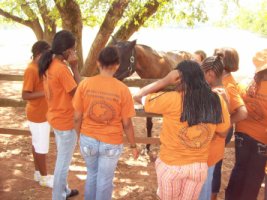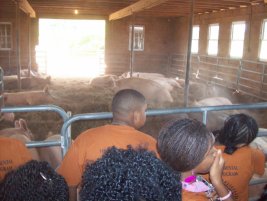Student Environmental Development Program
SEDP CANCELLED FOR 2013 and 2014 Due to Budget Constraints.
For more information on the Student Environmental Development Program, please contact Kathleen Kirkland, SEDP Director, (215) 814-5176, or kirkland.kathleen@epa.gov.
On this page:
Summary of the SEDP
Program History
Goals
SEDP Format
How Are Students Selected?
Sharing the Knowledge
Mentoring
How Long is the Program?
How Do We Measure Success?
How Can I Get Involved in the SEDP?
Past Program Participants and Partners
Summary of the SEDP
The SEDP is an environmental education and leadership development program. The students spend six-seven weeks of their summer at EPA Region 3 headquarters in Center City, Philadelphia, and on the campus of George Washington University, in Washington, D.C. and Johns Hopkins University in Baltimore, Md. There, they are taught by a middle school science teacher and given topic lectures by EPA employees and local professionals. The students participate in hands-on learning activities, outdoor education and extended learning experiences (field trips) which supplement their in-class learning. The versatile format can be used as a model for after school, summer, and/or day camp programs. The students are from diverse racial, economic, and cultural backgrounds and range in age from 12-14.

2008 SEDP class field trip
Program History
The SEDP program is nationally recognized and has been replicated in communities, including low income communities, throughout the nation. EPA Region 3 currently sponsors programs in Philadelphia, (eighteenth year) and Washington, D.C. (eleventh year) and Baltimore, Md. (second year). Wilmington, Del., now in the twelfth year, is a community based program, initiated by EPA, but continues under direction of the Delaware Center for Horticulture, as the Horticultural & Environmental Leadership Program (HELP). ![]() Past programs have also been located in the communities of Chester, Pa., and Baltimore.
Past programs have also been located in the communities of Chester, Pa., and Baltimore.
Goals
The goal of SEDP is to provide a holistic education for the students and help them become responsible adults. The students learn about environmental issues common to their urban communities, including contaminated fish consumption, children's asthma, sun safety, lead, polluted drinking water, and hazardous household waste. Students are also consciously exposed to cultural diversity through classroom activities and field trips. Diverse professionals from the community and government provide instruction and serve as excellent role models.
Life skills such as public speaking, working with group dynamics, and computer literacy are also necessary for successful completion of the course. Through this approach to education, general life and job skills, critical thinking, self esteem, team work, and personal and civic responsibility are all promoted. The major goal is for the students, after graduation from the program, to take their knowledge back to their own communities to teach others -- particularly elementary school kids -- about the impact of environmental issues on their lives.

2009 SEDP Field Trip
SEDP Format
Each SEDP is designed to address the specific needs of the community in which it is held. The students are encouraged and empowered to use critical thinking to look at the needs of their community and determine ways of addressing them. SEDP challenges students with finding innovative ways to educate their community on environmental health issues, such as, contaminated fish consumption, lead safety, pollution of the Anacostia River watershed, children's asthma, and other topics of direct relevance to the students. The students will develop outreach materials and presentations that will be shared with the local community and others.
How Are the Students Selected?
SEDP is a science-based academic enrichment program for seventh grade students. Students, who are achieving academically and demonstrate an interest in science, human health, or the environment, are nominated by their local middle schools. Applications are due in the spring of each year and compete to participate in the program during the summer prior to entering the eighth grade. The applications are reviewed by EPA and selections are made based on the student’s grades, attendance, extracurricular activities and behavior. The schools agree to support the program goals and provide assistance and opportunities for the students to teach others and showcase their talents.

2008 SEDP class field trip
Sharing the Knowledge
Students are given extensive communication and public speaking training, and many opportunities to practice their new skills. SEDP graduates will return to their communities and share their new-found knowledge. The students also take their knowledge on the road and give team presentations to a variety of audiences, including the staff of the U.S. Fish & Wildlife’s National Conservation & Training Center, EPA Regional offices and EPA Headquarters.
Mentoring
To ensure a smooth transition, classes have assigned mentors. We use cascade mentoring to give the students the best opportunity to adjust to the work world and the program. Cascade mentoring is the process of having mentors from different age groups give the students a better picture of how people achieve at different ages and levels. Our program mentors are eleventh grade through college. They work with the students each day and also act as teacher’s assistants. EPA staff members and summer interns also serve as personal mentors. The job of the mentors is to help develop another avenue of communication that may ease the students' adjustment and develop a professional relationship that will last well beyond the summer program.

2008 SEDP class field trip
How Long Is the Program ?
Each year the students spend six to seven weeks between July and August participating in SEDP. A typical work day is 8:30 a.m. to 2:30 p.m., Monday through Friday. On days when the students participate in extended learning experiences (field trips), the hours are adjusted accordingly. The graduation ceremony is held during the final week of the program and the students are required to participate in a group presentation of an environmentally related topic of their choosing. Graduation is one of the program highlights. Each team selects an environmental topic, such as lead poisoning, radon, water pollution, recycling, and pesticides, that they want to research and present in the form of skits, newscasts, and game shows, etc.
Evaluation Methods and Measurements of Success
Internally we measure success and the program's effectiveness through the pre and post test scores, by the number of schools who develop environmental science clubs, and by the number of classes and outreach activities conducted by the SEDP graduates. External reviews include post-program evaluations from an external panel of conservation and environmental professionals, the program teachers, participating schools, students and the program administrator.
The program is designed to meet and be evaluated by the American Association for the Advancement of Science's Benchmarks for Science Literacy and the North American Association for Environmental Education's Environmental Education’s Guidelines for Excellence in Environmental Education, with a the main focus on the Guidelines for Learning (K-12).
The American Association for the Advancement of Sciences Benchmarks for Science Literacy specifies how students should progress toward science literacy, recommending what they should know and be able to do by the time they reach certain grade levels. Benchmarks are a tool to be used by educators in designing a curriculum that makes sense to them and meets the standards for science literacy recommended by the Publication Science for All Americans.
The Excellence in Environmental Education--Guidelines for Learning (K-12)

2009 SEDP class field trip
How Can I Get Involved in The SEDP?
EPA staff and people from other organizations volunteer to work with the students. Everyone has something to offer from teaching classes, mentoring, chaperoning, administrative support, contacting schools and students, arranging trips, or just providing your ideas on how to improve the program. For more information on the Student Environmental Development Program, please Contact Kathleen Kirkland, SEDP Director, at (215) 814-5175 (kirkland.kathleen@epa.gov)
Current and Past Program Participants and Partners
American Forest Foundation (Project Learning Tree), American Red Cross, AmeriCorps*VISTA, Anacostia Watershed Association, Bureau of Land Management, Chesapeake Bay Foundation, Children's Environmental Health Network, Corporation for Community and National Community Service, District of Columbia Public Schools, District of Columbia Environmental Education Consortium, Earth Conservation Corps, ECC/Living Classrooms, District of Columbia Environmental Health Administration, National Aquarium at Baltimore, National Conservation Training Center, National Park Service, National Resources Conservation Service, National Wildlife Federation, Naval District Washington, North Light Community Center, Philadelphia Zoo, Smithsonian Institution, Smithsonian National Zoological Park, United Nations, Urban Treehouse, US Fish and Wildlife, US Forest Service, World Bank, and others.
Special thanks to George Washington University and Johns Hopkins for partnering with us and hosting the Washington, DC and Baltimore Programs.
![[logo] US EPA](../gif/logo_epaseal.gif)